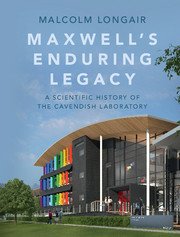Book contents
- Frontmatter
- Dedication
- Contents
- Preface
- Acknowledgements
- Part I To 1874
- Part II 1874 to 1879
- Part III 1879 to 1884
- Part IV 1884 to 1919
- Part V 1919 to 1937
- Part VI 1938 to 1953
- Part VII 1953 to 1971
- Part VIII 1971 to 1982
- Part IX 1984 to 1995
- 19 The Edwards era: a new epoch of expansion
- 20 The Edwards era: new directions in condensed matter physics
- 21 The Edwards era: high–energy physics and radio astronomy
- Part X 1995 to present
- Appendix The evolution of the New Museums site
- Notes
- References
- Author index
- Subject index
21 - The Edwards era: high–energy physics and radio astronomy
from Part IX - 1984 to 1995
Published online by Cambridge University Press: 05 July 2016
- Frontmatter
- Dedication
- Contents
- Preface
- Acknowledgements
- Part I To 1874
- Part II 1874 to 1879
- Part III 1879 to 1884
- Part IV 1884 to 1919
- Part V 1919 to 1937
- Part VI 1938 to 1953
- Part VII 1953 to 1971
- Part VIII 1971 to 1982
- Part IX 1984 to 1995
- 19 The Edwards era: a new epoch of expansion
- 20 The Edwards era: new directions in condensed matter physics
- 21 The Edwards era: high–energy physics and radio astronomy
- Part X 1995 to present
- Appendix The evolution of the New Museums site
- Notes
- References
- Author index
- Subject index
Summary
High-energy physics: the LEP era
The 1976 Report to the CERN Council recommended the construction of a Large Electron– Positron (LEP) collider capable of accelerating electrons and positrons to energies at which the W and Z bosons could be created in large numbers. The Council approved the project in 1981, the civil engineering work beginning in 1983. Excavation of the 27-kilometre circumference tunnel began in 1985 and was completed three years later – this excavation was Europe's largest civil-engineering project prior to the Channel Tunnel (see Figure 17.5). To measure the many products of electron–positron collisions, four huge detectors, ALEPH, DELPHI, L3 and OPAL, were installed at the experimental stations around the ring. As described in Section 17.3.1, CERN had already agreed a fast-track route to the discovery of theWand Z bosons and this was achieved in 1982–83. Now the task was to make precision measurements of their properties.
The LEP collider was commissioned in July 1989, its initial energy being about 91 GeV, at which energy Z bosons were created in huge numbers. LEP operated at about 100 GeV for seven years, a total of about 17 million Z particles being produced during that period. In 1995 LEP was upgraded to roughly twice that energy so that pairs of W bosons would be created as well – by 2000, the collider's maximum energy exceeded 209 GeV. During its 11 years of operation, the LEP experiments provided detailed information about the nature of the electroweak interaction as well as key tests of the standard model of particle physics. The Cavendish High Energy Physics Group became a member of the OPAL collaboration, which involved about 200 physicists from 34 institutes in Canada, Germany, Hungary, Italy, Israel, Japan, the United Kingdom and the United States – the acronym stands for Omni-Purpose Apparatus for LEP.
Janet Carter led the Cavendish participation in the OPAL experiment from about 1984. The group went through a further period of considerable crisis with the departure of Bill Neale to the Rutherford–Appleton Laboratory in 1988 and, even more seriously, the departure of the most senior scientist and head of the group, John Rushbrooke, to Australia in the same year.
- Type
- Chapter
- Information
- Maxwell's Enduring LegacyA Scientific History of the Cavendish Laboratory, pp. 506 - 518Publisher: Cambridge University PressPrint publication year: 2016



